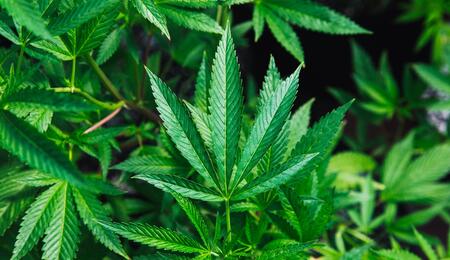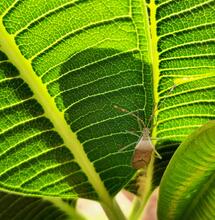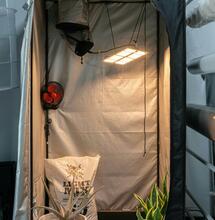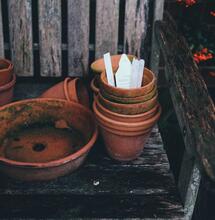NFT in practice

NFT is an automatic hydroponic system used successfully in many areas of growing, and growing cannabis is no exception. The system looks very simple at first glance, yet setting it up correctly gives many a grower a headache. Once assembled, the growing in this system, if done properly, can bring you great yields. Do you want to know how to achieve the best possible results?
How does it work
NFT stands for Nutrient Film Technique. Plants in rockwool cubes are placed on a grow tray. A nutrient solution flows through wrung channels in this tray. The solution is pumped up from a source tank using a small pump and a simple manifold. A layer of nonwoven fabric is placed on the bottom of the grow tray and the whole surface is covered by a thick non-transparent plastic board. Holes are cut in the board. Plants in rockwool cubes are placed in these holes. When the hydroponic system is turned on, the nutrient solution flows through the channels in the tray and humidifies the nonwoven fabric, as well as the rockwool cubes. Plant’s roots soon grow through the rockwool cubes and start spreading in the area between the bottom of the tray and the plastic cover.
Thanks to a constant supply of oxygen and nutrients, the conditions for growth are ideal there. When the roots are doing well, so are the parts of the plant above “ground”, as they have enough nutrients for healthy growth. NFT is a circulatory hydroponic system. The nutrient solution is pumped from the source tank to the system, from where it then returns to the tank. Although home growers mostly use systems with the growing tray, where plants are placed in two axes; there are also systems with separate tubes where the plants are placed in a single axis. The individual tubes are then placed next to each other.
Again, there are holes for the rockwool cubes cut in the upper part of the tubes. Hydroponic pots with ceramsite can also be used. The nutrient solution flows through the bottom under the plants, which again makes the nutrients available for the plants while at the same time allowing for enough oxygen in the roots area. When growing in tubes, the nonwoven fabric is usually not used. The tube system is very similar to aeroponic systems. Any average handyman can make their own tube system. Plastic tubes used for water distribution or drainage can easily be turned into growing tubes.
Although the NFT system is quite simple and it may seem that operating one is easy, sometimes this happens: Grower brings the system home, builds it according to the manual and plants the plants. But the miracle they expected doesn´t happen. On the contrary. Plants do not grow, leaves begin twisting and turning yellow. What's wrong? What did I miss? The catch is usually in setting the NFT's tilt, in the quality and temperature of the nutrient solution, or in the setting of the solution's flow. That's why NFT is more suitable for more advanced and experienced growers. However, when listening to the following advices, NFT can be harnessed even by an absolute beginner.
Setting tray’s angle and nutrient solution flow
The first principle for NFT to function correctly is a appropriate tilt of the grow tray or tube. If you bought a small NFT system like Gro-Tank, where the tray is as large as the nutrient solution tank, you have one worry less. The tilt angle is factory-set and suits your needs. In systems where the grow tray is resting on the tank on one end and supporting the base on the other, the angle must be set manually. The same is true for systems with tubes. The idea behind NFT is to cover the bottom of the tray with a thin layer of the nutrient solution. To make sure the layer is thin and of roughly the same depth everywhere, the tilt angle must be as small as possible.
That being said, it must still be large enough for the solution to flow from the tray back to the tank without forming puddles. When setting the tilt, 1–2 cm of declination per meter of length of the grow tray or tube should be enough. But there's no rule of the thumb here and the tilt must always be carefully set. Along with the tray's tilt, it's also good to set the nutrient's flow. Commercial NFT systems come with a valve for flow regulation. When making your own NFT, don't forget the valve. Install it on the pump's output or separately to each tube.
If the tilt and flow in systems with grow trays are set correctly, the nutrient solution flows evenly through all channels without overflowing. In tube systems, the water level at the outflow should not be much higher than at inflow. When fine-tuning the flow, the system must be placed on a flat surface. It's hard to achieve an even flow on tilted floor. Flow and tilt angle need to be set before placing the plants. Setting the system after placing them could ruin all your efforts because you they could be easily overwatered. The length of the grow tray or tube also play an important role. If building your own NFT, it is not recommended to make a single grow unit longer than 2 m. In case you need to cover a larger area, create more units. Water tends to amass at the outflow in too long units.
Pay attention to correct balancing of the grow tray and setting the flow correctly. Otherwise, the system won't work properly. It happens frequently that the flow is correct in the upper half of the system but the water accumulates in the lower part and drains slowly. In such cases, the plants grow well in a half of the system while being soaked with water in the other. Many growers then seem unable to identify the problem, which is in the tilt angle of the tray and in the flow. Check the flow of the nutrient solution even during the growth cycle. It may happen that the grow tray will bend due to an increase in weight of the plants and the solution's path will change. If you find some plants overwatering or drying, first check whether the solution flows evenly.
Laying the unwoven fabric correctly
Unwoven fabric serves as a backup for roots and for maintaining stable humidity in the root system area in tray-type NFT systems. The fabric is kept constantly wet and the roots grow through and on it. However, there are growers who don't use unwoven fabric in NFT and they're doing fine. Using the fabric in NFT systems with trays is highly recommended, though. The fabric should end a few centimeters before the spot where the water goes back to the tank. This ensures a reliable and even outflow. When the fabric overlaps the edge of the grow tray, it hampers the outflow.
Placing the plants in the system
Planting well-rooted plants in NFT is a very important step on the road towards successful harvest. Whether using rockwool cubes or hydroponic pots with rockwool, the roots must grow out of the growing medium already during planting. Only then can they reach the area in the NFT where they can get moisture and nutrients. Non-rooted plants don't grow very well in NFT. In rockwool cubes, non-rooted plants are quickly overwatered and subsequently die. [caption id="attachment_8268" align="alignnone" width="500"] Tube NFT system. You can make one of these yourselves.[/caption]
Irrigation
As with many other systems, the initial growth stage is crucial when using NFT. If want to grow in rockwool cubes, make sure to turn the irrigation system on and off manually for a short time several times a day during week one. Take care not to overwater the plants and, at the same time, provide them enough moisture. Optimum dose can be recognized by checking if the root system grows well. Rockwool cubes can retain water for quite a long time, so don't worry about them going dry in a few hours.
Once you notice that the root system is growing and the plants thrive, you may keep adding on irrigation until reaching constant flow. If using ceramsite and small hydroponic pots instead of rockwool cubes, irrigation must be turned on nonstop from the beginning. That's because a small amount of ceramsite will only retain a small amount of moisture and begin to dry fast. In case of an irrigation outage, the plants may start to wilt. If your growing place suffers from frequent power outages, go for the rockwool cubes.
When using irrigation in NFT, it is important to check nutrient solution parameters frequently, as with other circulatory hydroponic systems. Aside from everyday control and any necessary adjustments of pH and EC, it is also vital to check nutrient solution temperature. It should be kept around 21 °C. If over 23 °C, root development is significantly slowed down and the ability of roots to absorb nutrients is noticeably hampered, too. The same is true for temperatures below 18 °C, so try to keep the temperature in the desired limits. Although NFT ensures enough oxygen in the roots area by its technical characteristics, it is good to oxidize the nutrient solution tank, maintaining high levels of oxygen even there. An aquarium air compressor will suffice. By Mr. Jose



.png)